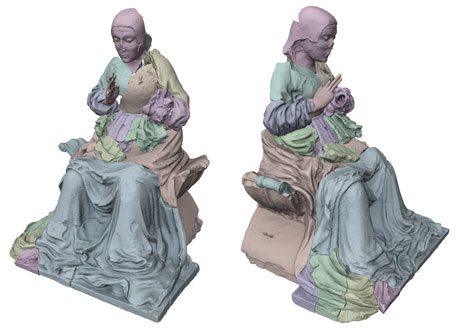by Marco Callieri, Roberto Scopigno and Elisabetta Sonnino
ISTI-CNR has been involved in the restoration of the Madonna of Pietranico, a terra-cotta statue severely damaged in the 2009 earthquake in central Italy, contributing expertise in 3D scanning and geometric processing.
The Madonna of Pietranico, a Renaissance terracotta statue fragmented in many pieces in the 2009 earthquake in central Italy, has undergone a detailed restoration. The complexity of the task convinced the coordinators of the necessity to set up a multi-disciplinary working group, with different backgrounds and expertise, in order to design and implement the restoration. The work was coordinated by Lucia Arbace (Cultural Heritage Superintendent of the Abruzzi Region) and by the chief restorer Elisabetta Sonnino. Although it was planned to employ traditional materials and methodologies, it was decided that the work should also be assisted by the application of digital technologies. Some innovative procedures were thus designed and developed to manage the reassembly and restoration process.

Figure 1: Images of the digitally recomposed statue (the different fragments are rendered with different surface color). This was the starting point for the actual physical restoration of the fragments.
A first important contribution was to produce a hypothesis for the recombination of the fragments of the statue. This initial phase of study and evaluation was performed on digitized 3D models of the fragments, with the aim of reducing the need to manipulate them physically, thus preventing further damage, and increasing the possibility of testing and evaluating different reassembly options. The accuracy of 3D scanning and the availability of software tools for their manipulation and visualization allowed us to manage this phase successfully (see the digital recombination of fragments in the image in Figure 1).
The next task was the design of the supporting structure (to hold all the fragments together). This phase was again accomplished by the synergic combination of consolidated restoration and mechanical methodologies with digital simulation, visualization and rapid prototyping techniques. This activity was coordinated by Antonio Iaccarino Idelson in cooperation with the restorers and the technical partners. The empty space within the sculpture, between the adjoining fragments, was precisely revealed by the digital reassembly. This visualization allowed us to "print in solid" the shape of the internal cavity and to use this to provide a rigid support for the fragments. 3D digital models were thus used to design and produce an innovative supporting structure, constructed with a rapid prototyping device (a 3D printer) by Tryeco srl.
Another important contribution was the study and virtual restoration of the polychrome decoration of the statue. On the basis of the traces remaining, our aim was to reproduce in the virtual 3D domain the very complex original polychrome decoration,. A side effect of this activity was to obtain insight into the limitations of current technologies in reproducing pictorial decorations over digital 3D models, and the consequent need for further improvements at the level of the digital tools.
A secondary goal of the project was to preserve the knowledge gathered on the artwork, including its history, its religious value and the restoration actions applied; a professional film director, Michele Bevilacqua, has produced a film documentary that presents the entire story in a pleasant and easy to follow manner; this video will be presented in museum exhibitions and, hopefully in the near future, on the web.
In conclusion, this restoration of the Madonna of Pietranico can be considered as a good example of how a modern restoration project should be planned and implemented. Consolidated solutions and procedures have been linked with a search for new approaches to solve specific problems. In many cases, the new methodologies were designed as a result of a collaboration between partners with very different backgrounds and made an extensive use of the digital media (3D scanning, geometric processing, virtual reassembly, visual analysis, rapid reproduction, and finally computer animation used for purposes of documentation). The work was extremely practical, driven by the specific needs of the restoration, and has allowed us to demonstrate the real effectiveness of new technological solutions.
Please contact:
Marco Callieri or Roberto Scopigno, ISTI-CNR, Italy
Elisabetta Sonnino, Abruzzi Region, Italy
E-mail: roberto.scopigno|










